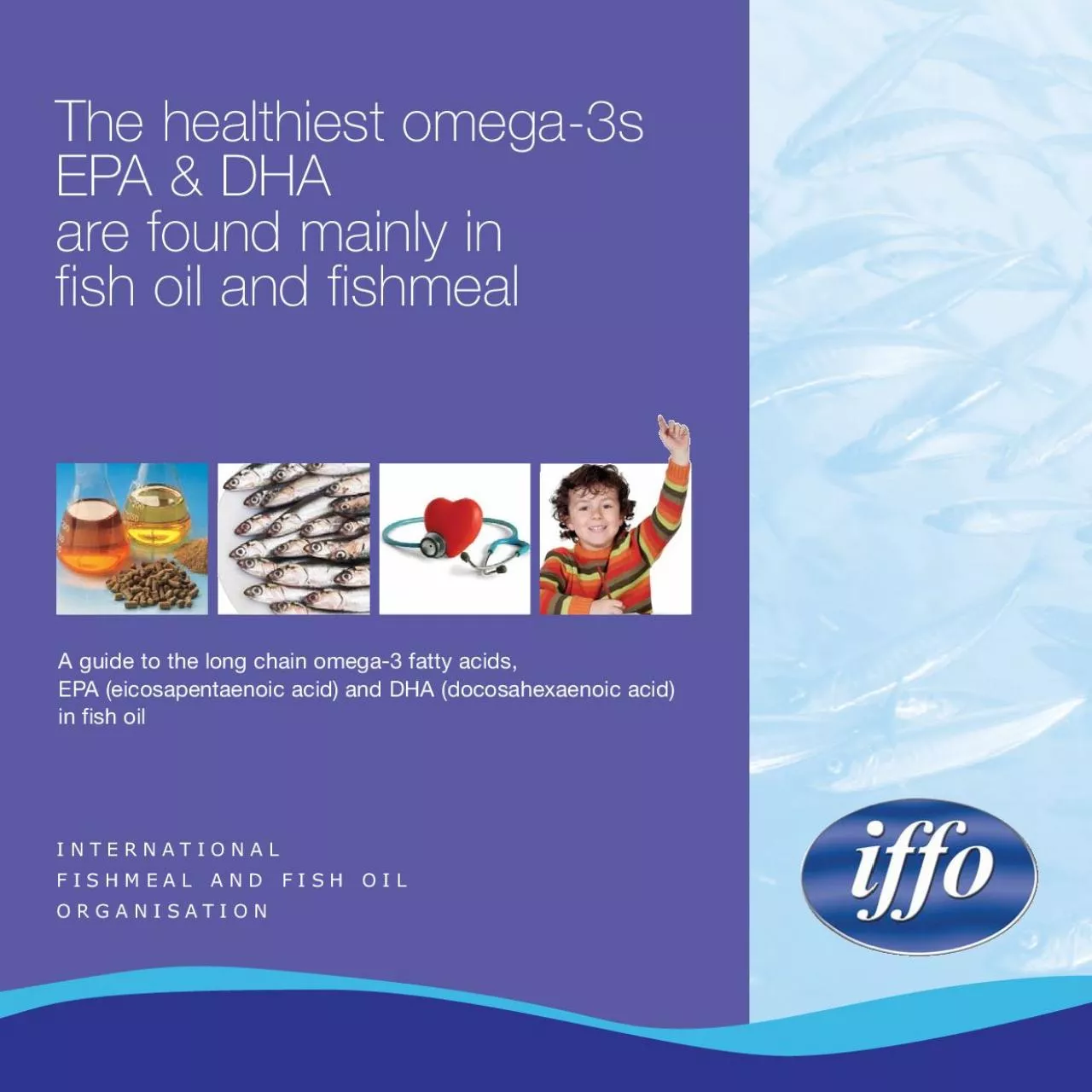

Plants and animals can synthesise many different fatty acidswhich perform a wide variety of different functions HoweverThis guide is focused on eicosapentaenoic acid EPAC205n3 and docosahexaenoi ID: 947284
Download Pdf The PPT/PDF document "EPA DHAEPA eicosapentaenoic acid and DH..." is the property of its rightful owner. Permission is granted to download and print the materials on this web site for personal, non-commercial use only, and to display it on your personal computer provided you do not modify the materials and that you retain all copyright notices contained in the materials. By downloading content from our website, you accept the terms of this agreement.
EPA & DHAEPA (eicosapentaenoic acid) and DHA (docosahexaenoic acid) Plants and animals can synthesise many different fatty acidswhich perform a wide variety of different functions. However,This guide is focused on eicosapentaenoic acid (EPAC20:5n-3) and docosahexaenoic acid (DHAC22:6 n-3),
which are theacids, or HUFAS. They are primarily marine-derived. EPAandDHAare synthesised by algae and marine plants, particularly incold water. The algae are eaten by zooplankton, the zooplanktonby fish and on up the food chain. At each stage the EPAandDHAare retained and utilised for thei
r properties. EPA& DHA,(18:3 n-3 ALA), which is plant derived, is described on page 14. 2 5 from increased consumption of EPA & DHA already have, cardiovascular disease. They make thesudden cardiac death. Three large control trials withschool and have improved academic ability.Western wor
ld. This and associated diseases, such The contemporary diet ischanges to our diets over time mean that most contemporary Westernseafood, the main dietary source of EPA& DHA. Young people inparticular are vastly under-consuming EPA& DHA. RECOMMENDED v. ACTUALINTAKENorth America 200mg/day,
UK 244mg/day, Australia 100mg/day and MidEurope 250mg/day. Japan is an exception at 900mg/day. source of DHAand the major dietary source for EPA. A2006 study in theUK showed that more than 80% of natural EPA& DHAin human dietsThe American Heart Association (AHA) is among the many organisati
onsand experts which advise adequate consumption of EPAand DHA. Itand menhaden, are rich in EPA& DHA often with between 1200mg and2000mg EPA& DHAper 100g.Seafoodsmg/100gOther Foodsmg/100g King salmon * � 2000 Omega-3 enriched foodsVaries Greenshell/lipped mussels #950 Eggs regular 8
0 Hoki (Blue grenadier)410 Turkey 30 Gemfish 400 Beef 20 Blue eye cod 310 Milk regular 0 Sydney rock oysters 300 Vegetable oils & spreads 0 Tuna canned 230 Regular bread 0 Snapper 220 Cereals, rice, pasta, etc 0 Barramundi saltwater 100 Fruit 0 Giant tiger prawn 100 Vegetables 0 Source: Fat
ty acid database, RMITUniversity, Australia as quoted on www .omega-3centre.com spring 2008.* Massey University analysis. # NZ Crop & Food analysis. predominant source of EPA & DHA 11 1.Farmed fish and seafood fed on a diet including adequate 2.Fish oil capsules or other LC omega-3 suppleme
nts.3.Meat, eggs or milk from animals whose feed is supplemented4.Enriched foods where LC omega-3 is added during manufacture.5.Wild captured fish and seafood.6.Meat, eggs or milk from animals whose diet is high inand menhaden, which therefore have high EPA& DHAcontent.Trimmings from food
fish processing are also converted to healthy 13 ÒOmega-3 benefits of farmed salmon are almost300 times greater than the contaminant risksÓ Fish oil is processed mainly from fish with a very short life span which means they absorb much less toxins such as dioxins, PCBs mercury. Farm-ra
ised salmon and rainbow trout have mercury levels Douglas R. Tocher, University of Stirling, 2007. 91% of PCBs in the American diet come from beef, chicken, pork, 15 There is strong and growing consumer, businessbehaviour. EPA& DHAare a major focus of this interest. Nearlythousands o
f newspaper, magazine and on-linein the international functional foods market. Theresearch company, Packaged Facts. Sales of fish oil interest in omega-3s Foods supplemented with EPA& DHAfrom fish oil are beingÒCan improve your childÕs brain function, attention,ÒAssists in the development o
f your babyÕs brain,nervous system, vision and intelligenceÓ ÒHelps reduce heart disease Ð the leading cause of deathÒRelieves joint inflammationÓÒMaintains a healthy immune systemÓÒImproves flexibility of blood vessels to improve circulationÓÒSupports the normal development of the brain, t
he eyesand the nervesÓÒA little fish your heart will loveÓ However, much of the marketing propaganda fails toomega-3s EPA& DHA(mainly from fish or marine oils) andomega-3s like ALA(from plants) which are Reduced effects of sepsis (E.coli) in young pigsPOULTRYCATTLE and HORSESbecome even mor
e important when producers of farmed livestock wish Agrowing body of scientific research continues to show that omega-3including pregnancy, lactation, foetal development, growth and aging.The benefits extend to helping companion animals when they suffermental alertness and inactivity. Omeg
a-3 fatty acids are recognised by veterinarians as important Benefits to animals continued Production and use offishmeal and fish oil Fishmeal and fish oil are produced by processing mainly small, bony, oilyfish, such as anchovy, herring, capelin & menhaden, for which thereis little demand
for human consumption. Asmaller percentage ismanufactured from fish offal, trimmings or cuttings, and other wasteswater, and soluble protein. The liquor is centrifuged to remove the oil,The solids are dried and ground to produce fishmeal. This usuallycontains 6 to 10% fish oil, but can be h
igher or lower. periods in the life cycles of pigs and poultry, and in pet food.globally, together with just under one million tonnes of fish oil. ThisOther important producing countries include Thailand, China, USA, 19 This guides contents are supported by a referenced paper, of increas
ing dietary levels of EPAand DHAomega-3 fatty acids in bothDr Andrew Jackson of IFFO and Anne Chamberlain, .if fo.net . www.omega-3centre.comInformation centre for Australia and New Zealand.www.goedomega3.comGlobal (Trade) Organisation for EPA& DHA.www.nutrition.org.ukwww.dpag.ox.ac.ukOx
ford University Department of Physiology Anatomy and Genetics.www.ucd.ie/lipgeneAproject on diet, genomics and the metabolic syndrome: an integrated nutrition,www.americanheart.orgAmerican Heart Association internationally. 2 College Yardt:+44 1727 842844f:+44 1727 842866e:secretariat@iffo.